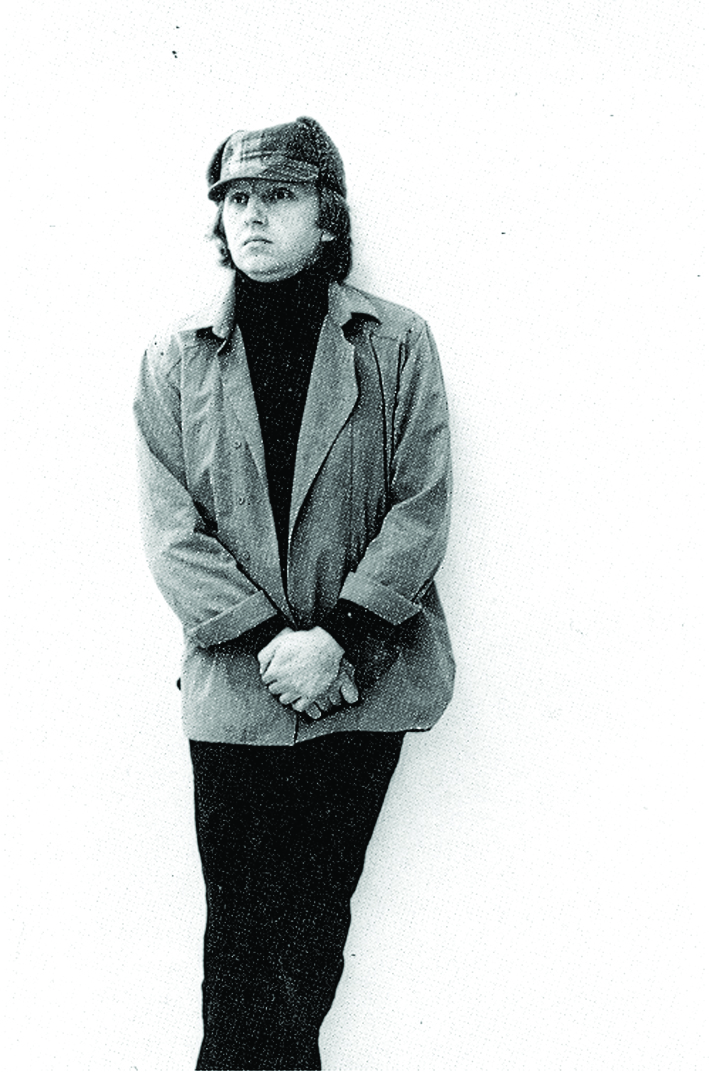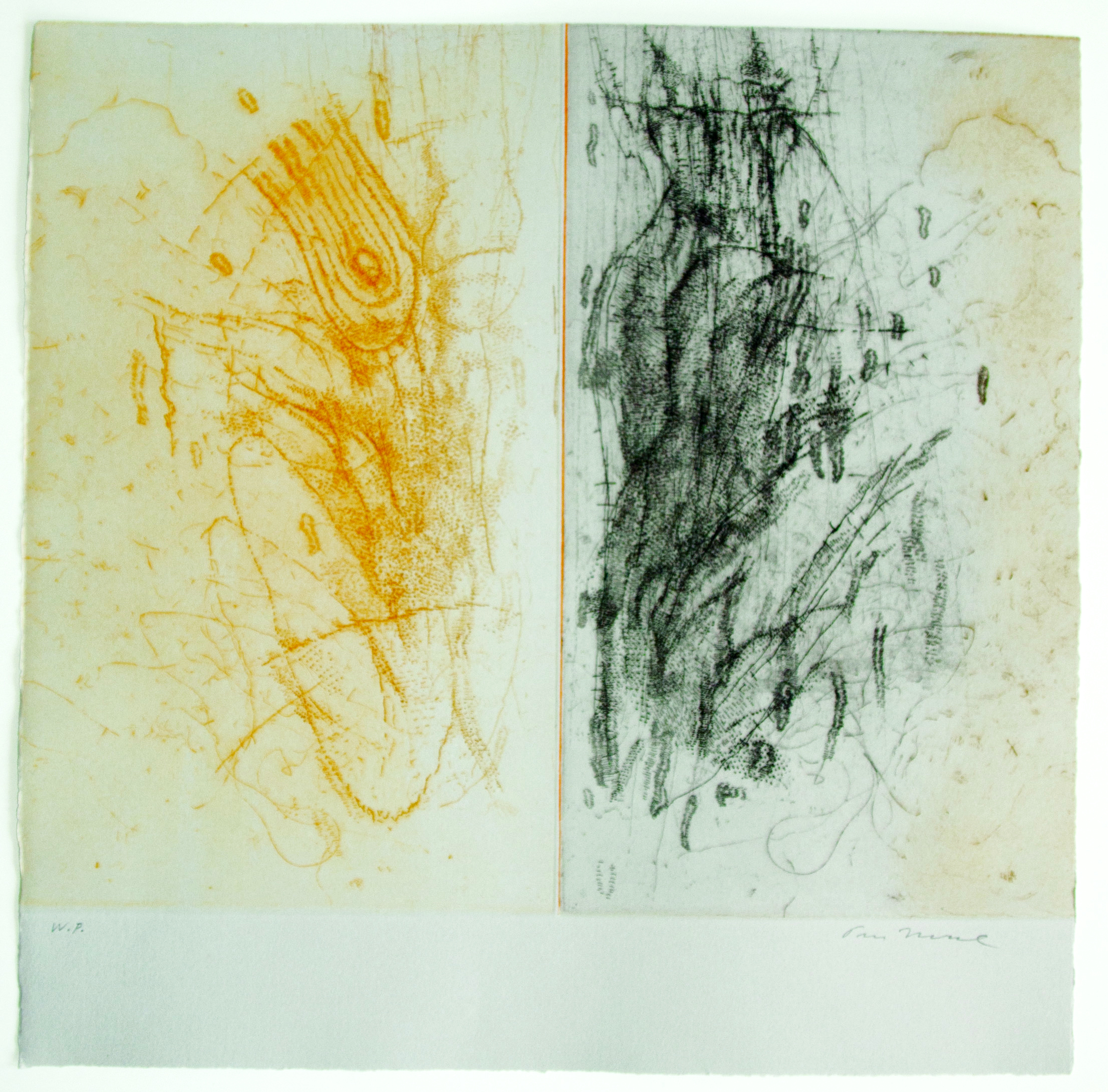
From top:
Petr Herel, Propitiator, 2010, etching on grey paper, edition of 35, 29 X 35 cm, printed by Bill Young Studio, Kinglake. PCA PRINT COMMISSION 2010
Petr Herel, c.1980.
Petr Herel was my teacher for many years, life-long mentor and friend.
I first came to work with him as a student in the Graphic Investigation Workshop in Canberra School of Art in 1980 when I was 17 years old, and he was 36.
I have known him across some 42 years….
My beginning in art coincided with Petr’s early beginning as Head of the Graphic Investigation Workshop, for he had just begun his tenure there in 1979 and he was given freedom to shape a workshop through experimental ideas; these ideas and concepts were questioning and searching but as Elizabeth Cross has just outlined, they were shaped by a very special tradition emanating from greater Europe and central to Prague….Petr embodied this tradition, however we were often clueless as to what this meant and we found out way through deep attention, many conversations, dark moods, and practice, practice, practice – but also through laughter.
The Art School was an Antipodean version of the Bauhaus– each Workshop was a world unto itself, Glass, Wood, Ceramics, Painting, Printmaking, Leather Craft, Gold and Silver, Sculpture, Textiles and the unique Graphic Investigation. Each workshop had a Head– often these masters came directly from Europe and each, like Petr, were steeped in a long tradition. To wander from Workshop to Workshop was like taking micro-trips across Europe. At that time there was a spirit of enormous optimism. The Canberra School of Art was still being built around us. Graphic Investigation in 1980 was an old Science Lab – a room with cabinets of oddities, such as animal skulls and sponges left over from the previous life as a High School; the lab was small and all we had, in the beginning was our own assorted private neuroses, a room, a place to sit, paper, pencils, pen, ink and Petr. He was actively building his vision for the oddly named Graphic Investigation –– it was to be an open workshop students could explore potentials through performance, film, animation, drawing, sculpture, painting and the oddest of all, artists books – the nexus between art and literature – where images had their own existence beyond the text, did not illustrate but strove to form an integrated unity.
He was a gifted teacher and communicator and he empowered students to develop their own voice – to believe in themselves. His form of teaching was very exacting. His manner was very Zen. It was commonly agreed that it was a form of teaching through osmosis – ideas would permeate through the community of souls who worked there.
In that first year we found it difficult to comprehend him, his English was hard to discern. But he managed to communicate in many ways. He would hand out a project which was hand-written and photocopied. A few of us would gather together trying to decipher the text…
We were hard at this one day when he walked by and said
“Oh you are trying to translate it! That is good!”
And then a mischievous laugh…
We often failed in this process. Failed to understand. But we stayed with it and would be rewarded, from time to time, with small demonstration drawings that he would spontaneously draw as we worked.
One day, as he walked by, he silently handed me a very small hand-written note.
I read it.
Looked back at him and nodded.
He nodded in return.
The note read:
“The world is large,
But in us it is as deep as the sea”
– Rilke
This moment has stayed with me my whole life and helped me to understand the truth.
That to be an artist is to search from within…to look for the answer within oneself….
He had a booming laugh which was only outmatched by his loving designer-artist wife and life-long partner Dorothy Herel. I first met Dorothy through her laughter – to hear them both laugh on sunny afternoons in the Graphic Investigation Workshop was really something. It was an unspoken challenge between us to make him laugh. Petr brought other inspirational teachers into our midst – internationals such as his collaborator Letterpress typographer and poet Thierry Bouchard – as well as many important artist-lecturers, such as, – Bernard Hardy (artist and poet), Gaynor Cardew (sculptor and papermaker), Leeanne Crisp (painter), Dianne Fogwell (artist, master printmaker), Kathy Nix (artist-papermaker), Peter Finlay (typographer) and Douglas Holleley (photographer) – to name a few.
He built the workshop over 20 years to include Letterpress and Paper-making facilities. Often his teaching and interest in his students extended beyond the years of their apprenticeship. He followed the careers of his students and nurtured them, opening doors through his contacts to collections, including the National Library of Australia and wider afield. Many of his students have been very successful and – scattered across the globe – gone on to be national and international artists, cabaret stars, provocateurs, animators, book publishers, teachers, and much more.
He was a pioneer of artist books within this country and made many wondrous, exquisite books and he leaves us an extraordinary legacy of these often unique one-off and limited editioned works which intertwine Literature with his own images. The images do not illustrate the text but move along a parallel trajectory.
They are difficult works to see. If they are put on display in closed cabinets, I have often noticed, astonished, that they seem to vanish and become invisible works. He would talk with pleasure about the expressions of those who first encountered these books and how they were greatly puzzled by their existence.
“But what is this!?” he would say mocking their reaction.
It gave him enormous pleasure that the works that he slaved over to make perfect, complicated layered works, were often incomprehensible to others.
These books are carefully assembled works from invisible realms, forms of consciousness, forms of active reading and works of the imagination. One needs to encounter these books alone on a one-to-one basis – without the barrier of glass or other voices. If he and his collaborators are successful, then the ego of the makers also vanish and there is only this silent dialogue between the reader the poet and the artists.
In a phone conversation he once told me that he was immensely glad that his teacher was someone born in the 19th Century as this meant that he was directly in contact with this era of consciousness; of this period of human perception, which embodied, without censorship, the full range of human aspiration, suffering, vulnerability and fragility.
He also once mentioned that he thought of himself as an outsider artist. What could he mean, I thought, there is nothing of the unschooled self-taught approach within his work which one associates with Art Brut artists, rather Petr’s work would regularly astonish others with the haunting images which arose from his great technical facility … the finely etched plates with an infinite number of fine lines and dots. But speaking about this with another former student, Alex Hamilton, who has known Petr for just as long, we came to think that he meant that he was outside the established lines of how art operates in the art world. However, no doubt this was an oblique utterance to remind us that there are layers of meaning and potential interpretation to even a statement such as this.
And that was Petr. A highly complex artist.
Nothing was as it seemed.
—
Join the PCA and become a member. You’ll get the fine-art quarterly print magazine Imprint, free promotion of your exhibitions, discounts on art materials and a range of other exclusive benefits.





